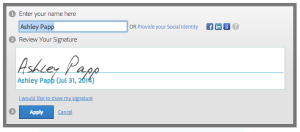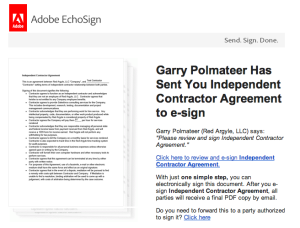 Signatures are an important part of just about every legal and business process. They’re also one of the actions that can seriously gum up the flow of business activities. For remote workers like me it’s an even bigger headache, because there’s no way to get documents for signature between any two people at Red Argyle in less than about a day. But even for an office-based business, it can be a hassle.
Signatures are an important part of just about every legal and business process. They’re also one of the actions that can seriously gum up the flow of business activities. For remote workers like me it’s an even bigger headache, because there’s no way to get documents for signature between any two people at Red Argyle in less than about a day. But even for an office-based business, it can be a hassle.
Thankfully, there are tools available to help you manage your signatures quickly and easily. At Red Argyle, we use a service called Echosign to capture electronic signatures for our business documents. We wanted to publish a blog post about how we use e-signatures to offer some ideas for how you might use them at your company. But before we jump into that, we thought it might be a good idea to do a quick overview of what electronic signatures are, as well as a bit of their history.
Everything Old Is New Again
Believe it or not, electronic signatures are almost as old as electronic communications themselves. Companies were remotely signing documents via telegraph in the decades leading up to the American Civil War. In fact, the first court ruling upholding the validity of telegraph electronic signatures was issued by the New Hampshire Supreme Court in 1869!
For the most part though, it seems that e-signatures came into their own in the 1980’s during the heyday of the fax machine. Mostly this owed to the speed advantage of faxes over sending physical documents. Even though the signatures in this case were actually physical, they were transmitted electronically. Modern electronic signatures seem to have come full-circle, reaching a state much closer to their telegraphic origins.
Are Electronic Signatures As Good As Print?
 So what are the main differences between a physical and an electronic signature, other than the obvious lack of ink and paper? Well, from a legal standpoint, the differences are few if any. Many places have laws enforcing the legal validity of electronic signatures, including the United States, Canada, European Union, United Kingdom, Japan, and many others.
So what are the main differences between a physical and an electronic signature, other than the obvious lack of ink and paper? Well, from a legal standpoint, the differences are few if any. Many places have laws enforcing the legal validity of electronic signatures, including the United States, Canada, European Union, United Kingdom, Japan, and many others.
While the law affirms that e-signatures are valid, it doesn’t always lay out much information on what form they have to take. US law defines an electronic signature as “an electronic sound, symbol, or process, attached to or logically associated with a contract or other record and executed or adopted by a person with the intent to sign the record.” That’s a fancy way of saying that if the person doing the signing believes it’s an e-signature, then the law considers it an e-signature. It doesn’t even have to be in the form of text; when you click the “I have read and agree to the terms of this EULA” button on basically every piece of software that you download or use, that’s another form of electronic signature.
Wrapping Up
So hopefully this has given you a quick overview of what electronic signatures are and a bit of their history. In my next post, I’ll look more into the practical applications of e-signatures, including how we’re using them at Red Argyle, and some options to integrate Salesforce and e-signatures to help you speed up your business processes.






